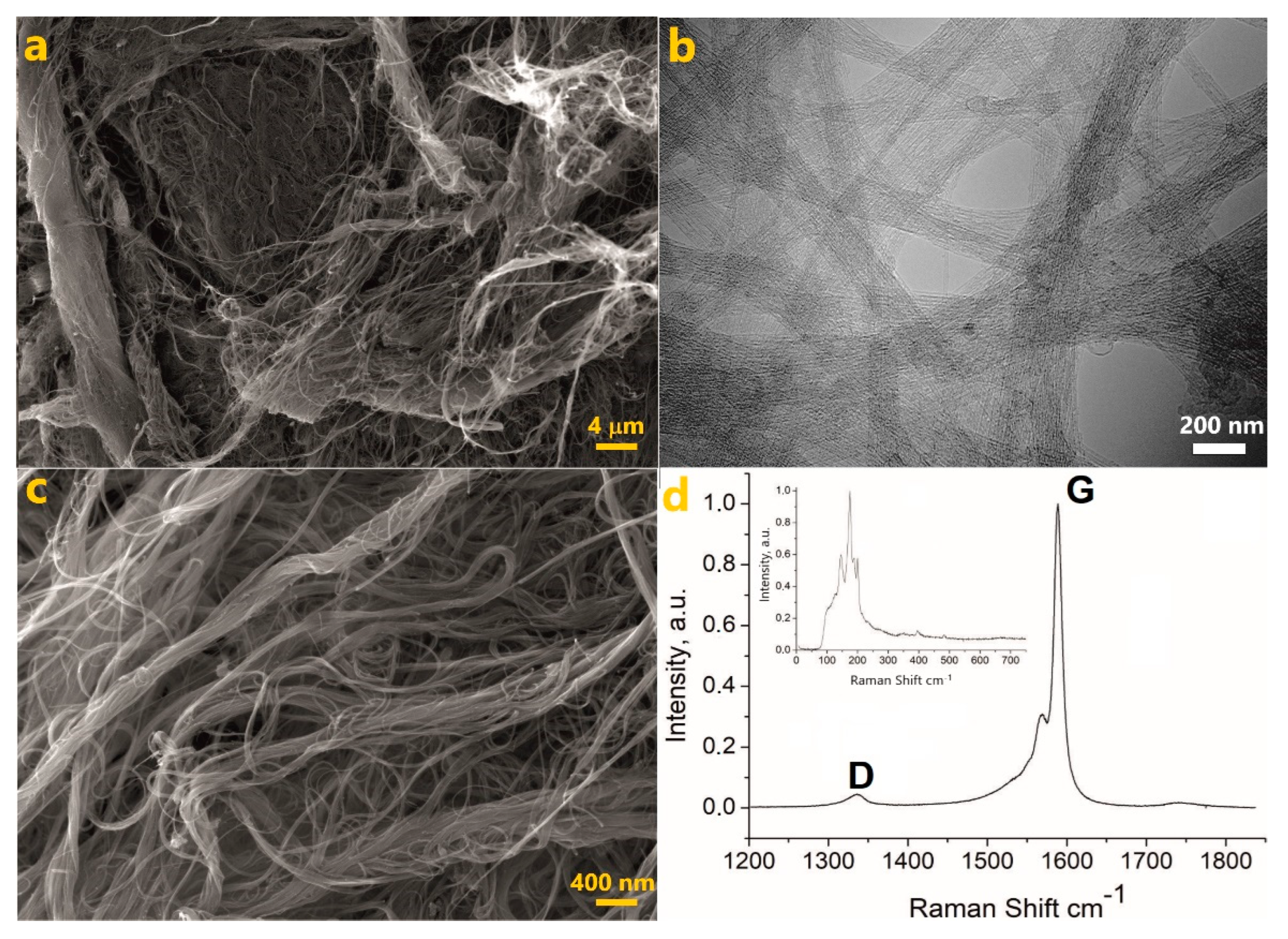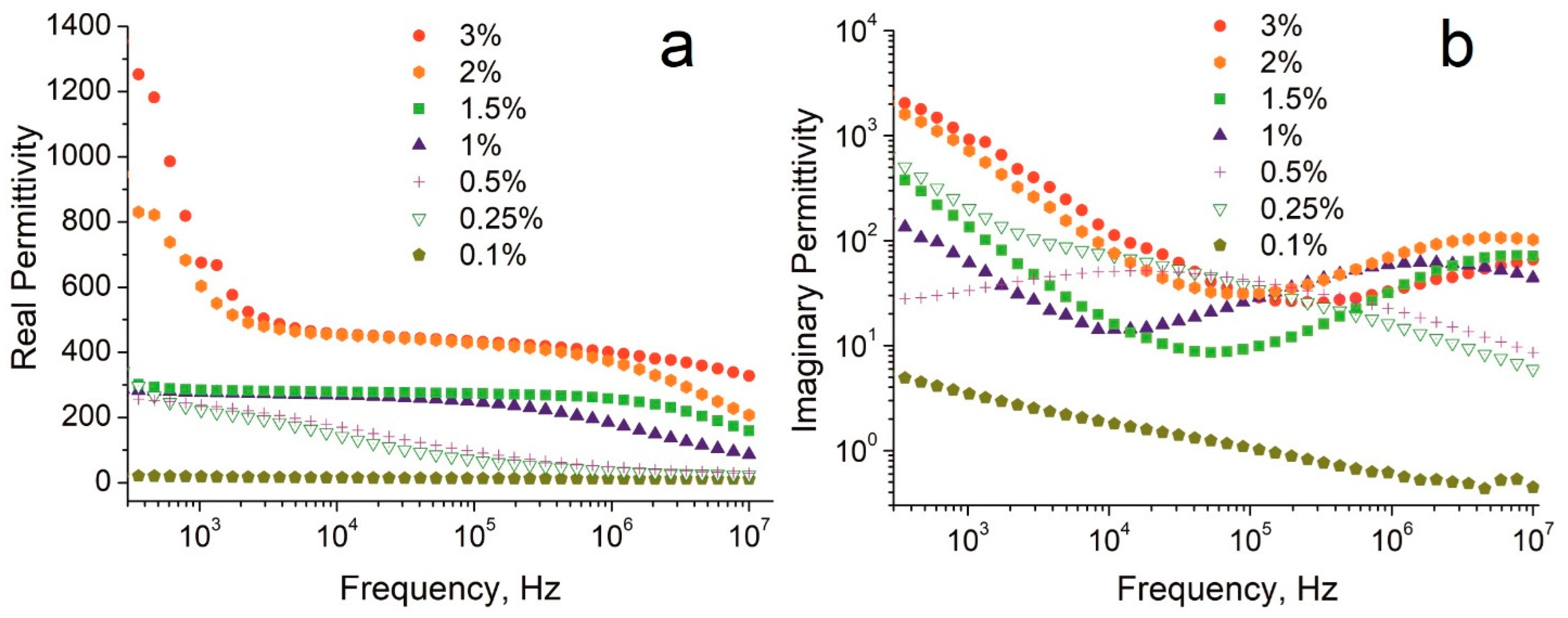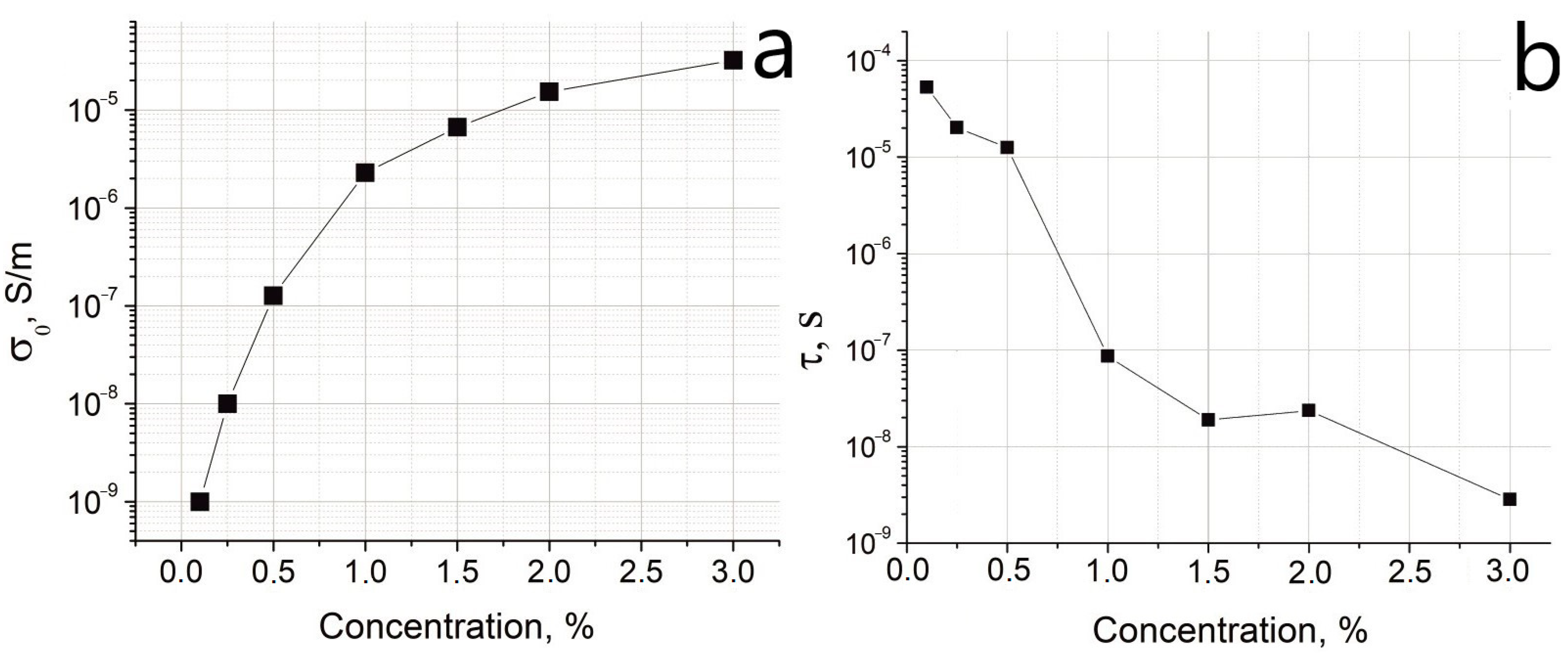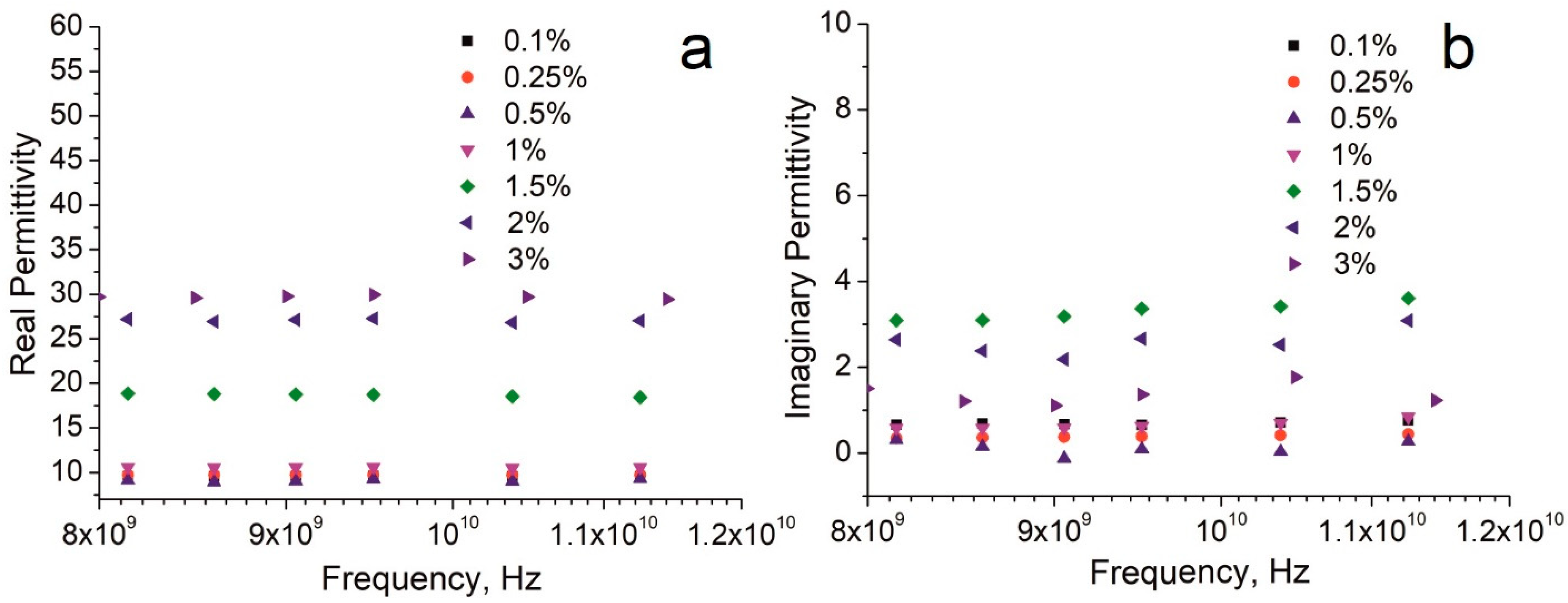High Permittivity Polymer Composites on the Basis of Long Single-Walled Carbon Nanotubes: The Role of the Nanotube Length
Abstract
1. Introduction
2. Experimental
2.1. Materials
2.2. Characterization
2.3. Preparation of Polymer Composites
2.4. Electrical Measurements
3. Results and Discussion
- (A)
- Group I—composites with a filler content of 0.1–0.5%;
- (B)
- Group II—composites with a filler content of 1 and 1.5%;
- (C)
- Group III—composites with a filler content of 2 and 3%.
- I
- composites with filler content of 0.1–1%;
- II
- composite with filler content of 1.5%;
- III
- composites with filler content of 2–3%.
4. Conclusions
Supplementary Materials
Author Contributions
Funding
Data Availability Statement
Conflicts of Interest
References
- Boughias, O.; Belkaid, M.S.; Zirmi, R.; Trigaud, T.; Ratier, B.; Ayoub, N. Field Effect Transistors Based on Composite Films of Poly(4-Vinylphenol) with ZnO Nanoparticles. J. Electron. Mater. 2018, 47, 2447. [Google Scholar] [CrossRef]
- James, D.K.; Tour, J.M. Graphene: Powder, Flakes, Ribbons, and Sheets. Acc. Chem. Res. 2013, 46, 2307. [Google Scholar] [CrossRef]
- Younes, H.; Li, R.; Lee, S.E.; Kim, Y.K.; Choi, D. Gradient 3D-Printed Honeycomb Structure Polymer Coated with a Composite Consisting of Fe3O4 Multi-Granular Nanoclusters and Multi-Walled Carbon Nanotubes for Electromagnetic Wave Absorption. Synth. Met. 2021, 275, 116731. [Google Scholar] [CrossRef]
- Ismail, M.M.; Rafeeq, S.N.; Sulaiman, J.M.A.; Mandal, A. Electromagnetic Interference Shielding and Microwave Absorption Properties of Cobalt Ferrite CoFe2O4/Polyaniline Composite. Appl. Phys. A Mater. Sci. Process. 2018, 124, 1–12. [Google Scholar] [CrossRef]
- Pawar, S.P.; Bose, S. Extraordinary Synergy in Attenuating Microwave Radiation with Cobalt-Decorated Graphene Oxide and Carbon Nanotubes in Polycarbonate/Poly(Styrene-Co-Acrylonitrile) Blends. ChemNanoMat 2015, 1, 603. [Google Scholar] [CrossRef]
- Yusof, Y.; Moosavi, S.; Johan, M.R.; Badruddin, I.A.; Wahab, Y.A.; Hamizi, N.A.; Rahman, M.A.; Kamangar, S.; Khan, T.M.Y. Electromagnetic Characterization of a Multiwalled Carbon Nanotubes-Silver Nanoparticles-Reinforced Polyvinyl Alcohol Hybrid Nanocomposite in X-Band Frequency. ACS Omega 2021, 6, 4184. [Google Scholar] [CrossRef]
- Panda, S.; Goswami, S.; Acharya, B. Polydimethylsiloxane-Multiwalled Carbon Nanotube Nanocomposites as Dielectric Materials: Frequency, Concentration, and Temperature-Dependence Studies. J. Electron. Mater. 2019, 48, 2853. [Google Scholar] [CrossRef]
- Cai, C.; Chen, T.; Chen, X.; Zhang, Y.T.; Gong, X.H.; Wu, C.G.; Hu, T. Enhanced Electromechanical Properties of Three-Phased Polydimethylsiloxane Nanocomposites via Surface Encapsulation of Barium Titanate and Multiwalled Carbon Nanotube with Polydopamine. Macromol. Mater. Eng. 2021, 306, 2100046. [Google Scholar] [CrossRef]
- Jiang, M.J.; Dang, Z.M.; Xu, H.P. Giant Dielectric Constant and Resistance-Pressure Sensitivity in Carbon Nanotubes/Rubber Nanocomposites with Low Percolation Threshold. Appl. Phys. Lett. 2007, 90, 042914. [Google Scholar] [CrossRef]
- Lopes, B.H.K.; Portes, R.C.; Amaral Junior, M.A.D.; Florez-Vergara, D.E.; Gama, A.M.; Silva, V.A.; Quirino, S.F.; Baldan, M.R. X Band Electromagnetic Property Influence of Multi-Walled Carbon Nanotube in Hybrid MnZn Ferrite and Carbonyl Iron Composites. J. Mater. Res. Technol. 2020, 9, 2369. [Google Scholar] [CrossRef]
- Dimiev, A.; Lu, W.; Zeller, K.; Crowgey, B.; Kempel, L.C.; Tour, J.M. Low-Loss, High-Permittivity Composites Made from Graphene Nanoribbons. ACS Appl. Mater. Interfaces 2011, 3, 4657. [Google Scholar] [CrossRef] [PubMed]
- Dimiev, A.; Zakhidov, D.; Genorio, B.; Oladimeji, K.; Crowgey, B.; Kempel, L.; Rothwell, E.J.; Tour, J.M. Permittivity of Dielectric Composite Materials Comprising Graphene Nanoribbons. the Effect of Nanostructure. ACS Appl. Mater. Interfaces 2013, 5, 7567. [Google Scholar] [CrossRef] [PubMed]
- Lounev, I.V.; Musin, D.R.; Dimiev, A.M. New Details to Relaxation Dynamics of Dielectric Composite Materials Comprising Longitudinally Opened Carbon Nanotubes. J. Phys. Chem. C 2017, 121, 22995. [Google Scholar] [CrossRef]
- Zhang, Z.; Sun, S.; Liu, L.; Yu, K.; Liu, Y.; Leng, J. Dielectric Properties of Carbon Nanotube/Silicone Elastomer Composites. In Proceedings of SPIE; SPIE: Bellingham, WA, USA, 2009; Volume 7493, p. 749315-1. [Google Scholar]
- Pantazi, A.G.; Oprea, O.; Pantazi, A.; Palade, S.; Berbecaru, C.; Purica, M.; Matei, A.; Oprea, O.; Dragoman, D. Dielectric Properties of Multiwall Carbon Nanotube-Red Silicone Rubber Composites. J. Optoelectron. Adv. Mater. 2015, 17, 1319. [Google Scholar]
- Wang, F.; Wang, J.W.; Li, S.Q.; Xiao, J. Dielectric Properties of Epoxy Composites with Modified Multiwalled Carbon Nanotubes. Polym. Bull. 2009, 63, 101. [Google Scholar] [CrossRef]
- Zhao, K.; Gupta, S.; Chang, C.; Wei, J.; Tai, N.H. Layered Composites Composed of Multi-Walled Carbon Nanotubes/Manganese Dioxide/Carbon Fiber Cloth for Microwave Absorption in the X-Band. RSC Adv. 2019, 9, 19217. [Google Scholar] [CrossRef]
- Sotiropoulos, A.; Koulouridis, S.; Masouras, A.; Kostopoulos, V.; Anastassiu, H.T. Carbon Nanotubes Films in Glass Fiber Polymer Matrix Forming Structures with High Absorption and Shielding Performance in X-Band. Compos. Part B Eng. 2021, 217, 108896. [Google Scholar] [CrossRef]
- Dimiev, A.M.; Surnova, A.; Lounev, I.; Khannanov, A. Intrinsic Insertion Limits of Graphene Oxide into Epoxy Resin and the Dielectric Behavior of Composites Comprising Truly 2D Structures. J. Phys. Chem. C 2019, 123, 3461. [Google Scholar] [CrossRef]
- Dimiev, A.M.; Lounev, I.; Khamidullin, T.; Surnova, A.; Valimukhametova, A.; Khannanov, A. Polymer Composites Comprising Single-Atomic-Layer Graphenic Conductive Inclusions and Their Unusual Dielectric Properties. J. Phys. Chem. C 2020, 124, 13715. [Google Scholar] [CrossRef]
- Li, Q.; Xue, Q.; Hao, L.; Gao, X.; Zheng, Q. Large Dielectric Constant of the Chemically Functionalized Carbon Nanotube/Polymer Composites. Compos. Sci. Technol. 2008, 68, 2290. [Google Scholar] [CrossRef]
- Shang, S.; Tang, C.; Jiang, B.; Song, J.; Jiang, B.; Zhao, K.; Liu, Y.; Wang, X. Enhancement of Dielectric Permittivity in Carbon Nanotube/Polyvinylidene Fluoride Composites by Constructing of Segregated Structure. Compos. Commun. 2021, 25, 100745. [Google Scholar] [CrossRef]
- Wang, L.; Dang, Z.M. Carbon Nanotube Composites with High Dielectric Constant at Low Percolation Threshold. Appl. Phys. Lett. 2005, 87, 042903. [Google Scholar] [CrossRef]
- Yuan, J.K.; Yao, S.H.; Dang, Z.M.; Sylvestre, A.; Genestoux, M.; Bai, J. Giant Dielectric Permittivity Nanocomposites: Realizing True Potential of Pristine Carbon Nanotubes in Polyvinylidene Fluoride Matrix through an Enhanced Interfacial Interaction. J. Phys. Chem. C 2011, 115, 5515. [Google Scholar] [CrossRef]
- Jun, Y.S.; Habibpour, S.; Hamidinejad, M.; Park, M.G.; Ahn, W.; Yu, A.; Park, C.B. Enhanced Electrical and Mechanical Properties of Graphene Nano-Ribbon/Thermoplastic Polyurethane Composites. Carbon 2021, 174, 305. [Google Scholar] [CrossRef]
- Kasgoz, A.; Korkmaz, M.; Durmus, A. Compositional and Structural Design of Thermoplastic Polyurethane/Carbon Based Single and Multi-Layer Composite Sheets for High-Performance X-Band Microwave Absorbing Applications. Polymer 2019, 180, 121672. [Google Scholar] [CrossRef]
- Wang, P.; Yang, L.; Zhou, Y.; Gao, S.; Cao, T.; Feng, S.; Xu, P.; Ding, Y. Synergistic Effect of EVA-GMA and Nanofillers on Mechanical and Dielectric Properties of Polyamide. Compos. Commun. 2021, 25, 100738. [Google Scholar] [CrossRef]
- Grimes, C.A.; Dickey, E.C.; Mungle, C.; Ong, K.G.; Qian, D. Effect of Purification of the Electrical Conductivity and Complex Permittivity of Multiwall Carbon Nanotubes. J. Appl. Phys. 2001, 90, 4134. [Google Scholar] [CrossRef]
- Baughman, R.H.; Zakhidov, A.A.; De Heer, W.A. Carbon Nanotubes—The Route toward Applications. Science 2002, 297, 787. [Google Scholar] [CrossRef] [PubMed]
- Grimes, C.A.; Mungle, C.; Kouzoudis, D.; Fang, S.; Eklund, P.C. The 500 MHz to 5.50 GHz Complex Permittivity Spectra of Single-Wall Carbon Nanotube-Loaded Polymer Composites. Chem. Phys. Lett. 2000, 319, 460. [Google Scholar] [CrossRef]
- Dash, K.; Hota, N.K.; Sahoo, B.P. Fabrication of Thermoplastic Polyurethane and Polyaniline Conductive Blend with Improved Mechanical, Thermal and Excellent Dielectric Properties: Exploring the Effect of Ultralow-Level Loading of SWCNT and Temperature. J. Mater. Sci. 2020, 55, 12568. [Google Scholar] [CrossRef]
- Badawi, A.; Alharthi, S.S.; Assaedi, H.; Alharbi, A.N.; Althobaiti, M.G. Cd0.9Co0.1S Nanostructures Concentration Study on the Structural and Optical Properties of SWCNTs/PVA Blend. Chem. Phys. Lett. 2021, 775, 138701. [Google Scholar] [CrossRef]
- Puértolas, J.A.; García-García, J.F.; Pascual, F.J.; González-Domínguez, J.M.; Martínez, M.T.; Ansón-Casaos, A. Dielectric Behavior and Electrical Conductivity of PVDF Filled with Functionalized Single-Walled Carbon Nanotubes. Compos. Sci. Technol. 2017, 152, 263. [Google Scholar] [CrossRef]
- Abdelrazek, E.M.; Elashmawi, I.S.; Hezma, A.M.; Rajeh, A.; Kamal, M. Effect of an Encapsulate Carbon Nanotubes (CNTs) on Structural and Electrical Properties of PU/PVC Nanocomposites. Phys. B Condens. Matter 2016, 502, 48. [Google Scholar] [CrossRef]
- Khamidullin, T.; Galyaltdinov, S.; Valimukhametova, A.; Brusko, V.; Khannanov, A.; Maat, S.; Kalinina, I.; Dimiev, A.M. Simple, Cost-Efficient and High Throughput Method for Separating Single-Wall Carbon Nanotubes with Modified Cotton. Carbon 2021, 178, 157. [Google Scholar] [CrossRef]
- Krestinin, A.V.; Dremova, N.N.; Knerel’Man, E.I.; Blinova, L.N.; Zhigalina, V.G.; Kiselev, N.A. Characterization of SWCNT Products Manufactured in Russia and the Prospects for Their Industrial Application. Nanotechnologies Russ. 2015, 10, 537. [Google Scholar] [CrossRef]
- Nano, A.; Chortos, A.; Pochorovski, I.; Lin, P.; Pitner, G.; Yan, X.; Gao, T.Z.; To, J.W.F.; Lei, T.; Will, J.W.; et al. Universal Selective Dispersion of Semiconducting Carbon Nanotubes from Commercial Sources Using a Supramolecular Polymer. ACS Nano 2017, 11, 5660. [Google Scholar]
- Salamatov, I.N.; Yatsenko, D.A.; Khasin, A.A. Determination of the Diameter Distribution Function of Single-Wall Carbon Nanotubes by the X-Ray Diffraction Data. J. Struct. Chem. 2019, 60, 2001. [Google Scholar] [CrossRef]
- Maus, C. TUBALL Single Wall Carbon Nanotubes: A New Additive for Thermoplastics. Soc. Plast. Eng. 2017, 2193. [Google Scholar]
- da Silva, V.A.; Rezende, M.C. S-Parameters, Electrical Permittivity, and Absorbing Energy Measurements of Carbon Nanotubes-Based Composites in X-Band. J. Appl. Polym. Sci. 2021, 138, e49843. [Google Scholar] [CrossRef]
- Shayesteh Zeraati, A.; Mende Anjaneyalu, A.; Pawar, S.P.; Abouelmagd, A.; Sundararaj, U. Effect of Secondary Filler Properties and Geometry on the Electrical, Dielectric, and Electromagnetic Interference Shielding Properties of Carbon Nanotubes/Polyvinylidene Fluoride Nanocomposites. Polym. Eng. Sci. 2021, 61, 959. [Google Scholar] [CrossRef]
- Bizhani, H.; Katbab, A.A.; Lopez-Hernandez, E.; Miranda, J.M.; Lopez-Manchado, M.A.; Verdejo, R. Preparation and Characterization of Highly Elastic Foams with Enhanced Electromagnetic Wave Absorption Based on Ethylene-Propylene-Diene-Monomer Rubber Filled with Barium Titanate/Multiwall Carbon Nanotube Hybrid. Polymers 2020, 12, 2278. [Google Scholar] [CrossRef]
- Novocontrol Technologies Presents WinFIT. Available online: https://www.novocontrol.de/brochures/WinFIT.pdf (accessed on 12 December 2021).
- Kataura, H. Bundle Effects of Single-Wall Carbon Nanotubes. AIP Conf. Proc. 2000, 544, 262. [Google Scholar]
- Alvarez, L.; Righi, A.; Guillard, T.; Rols, S.; Anglaret, E.; Laplaze, D.; Sauvajol, J.-L.; Francé, F. Resonant Raman Study of the Structure and Electronic Properties of Single-Wall Carbon Nanotubes. Chem. Phys. Lett. 2000, 316, 186. [Google Scholar] [CrossRef]
- Jonscher, A.K. Dielectric Relaxation in Solids. J. Phys. D Appl. Phys. 1999, 32, R57. [Google Scholar] [CrossRef]
- Prodromakis, T.; Papavassiliou, C. Engineering the Maxwell–Wagner Polarization Effect. Appl. Surf. Sci. 2009, 255, 6989. [Google Scholar] [CrossRef]
- Cole, R.H. On the Analysis of Dielectric Relaxation. J. Chem. Phys. 1955, 23, 493. [Google Scholar] [CrossRef]
- Lee, S.E.; Kang, J.H.; Kim, C.G. Fabrication and Design of Multi-Layered Radar Absorbing Structures of MWNT-Filled Glass/Epoxy Plain-Weave Composites. Compos. Struct. 2006, 76, 397. [Google Scholar] [CrossRef]






| Polymer Host/Filler | CNT (wt%) | ε′ at 104 Hz | ε′ at 106 Hz | Ref. |
|---|---|---|---|---|
| PDMS/MWCNTs | 3 | ~4.5 | ~4.3 | [14] |
| Silicon rubber/MWCNTs | 2.5 | ~4.5 | ~4.4 | [15] |
| PVDF/functionalized MWCNTs | 3.5 | ~250 | ~200 | [21] |
| PVDF/MWCNTs | 3.7 | 160 | ~100 | [22] |
| PVDF/MWCNTs | 2 | ~225 | ~50 | [23] |
| PVDF/MWCNTs | 4 | ~30 | ~25 | [24] |
| TPU-PANI/SWCNTs | 0.5 | ~100 | ~80 | [31] |
| Silicon rubber/SWCNTs | 2 | ~450 | ~360 | This work |
| Polymer Host/Filler | CNT Loading Fraction, % | ε′ | Ref. |
|---|---|---|---|
| Epoxy resin/MWCNTs | 1 | ~4.75 | [18] |
| TPU/MWCNTs | 3 | ~13 | [26] |
| Epoxy resin/MWCNTs | 2 | 3.0 | [40] |
| PVDF/MWCNTs | 3 | ~23 | [41] |
| Silicone/SWCNTs | 2 | ~27 | This work |
| Silicone/SWCNTs | 3 | ~30 | This work |
Publisher’s Note: MDPI stays neutral with regard to jurisdictional claims in published maps and institutional affiliations. |
© 2022 by the authors. Licensee MDPI, Basel, Switzerland. This article is an open access article distributed under the terms and conditions of the Creative Commons Attribution (CC BY) license (https://creativecommons.org/licenses/by/4.0/).
Share and Cite
Galyaltdinov, S.; Lounev, I.; Khamidullin, T.; Hashemi, S.A.; Nasibulin, A.; Dimiev, A.M. High Permittivity Polymer Composites on the Basis of Long Single-Walled Carbon Nanotubes: The Role of the Nanotube Length. Nanomaterials 2022, 12, 3538. https://doi.org/10.3390/nano12193538
Galyaltdinov S, Lounev I, Khamidullin T, Hashemi SA, Nasibulin A, Dimiev AM. High Permittivity Polymer Composites on the Basis of Long Single-Walled Carbon Nanotubes: The Role of the Nanotube Length. Nanomaterials. 2022; 12(19):3538. https://doi.org/10.3390/nano12193538
Chicago/Turabian StyleGalyaltdinov, Shamil, Ivan Lounev, Timur Khamidullin, Seyyed Alireza Hashemi, Albert Nasibulin, and Ayrat M. Dimiev. 2022. "High Permittivity Polymer Composites on the Basis of Long Single-Walled Carbon Nanotubes: The Role of the Nanotube Length" Nanomaterials 12, no. 19: 3538. https://doi.org/10.3390/nano12193538
APA StyleGalyaltdinov, S., Lounev, I., Khamidullin, T., Hashemi, S. A., Nasibulin, A., & Dimiev, A. M. (2022). High Permittivity Polymer Composites on the Basis of Long Single-Walled Carbon Nanotubes: The Role of the Nanotube Length. Nanomaterials, 12(19), 3538. https://doi.org/10.3390/nano12193538







